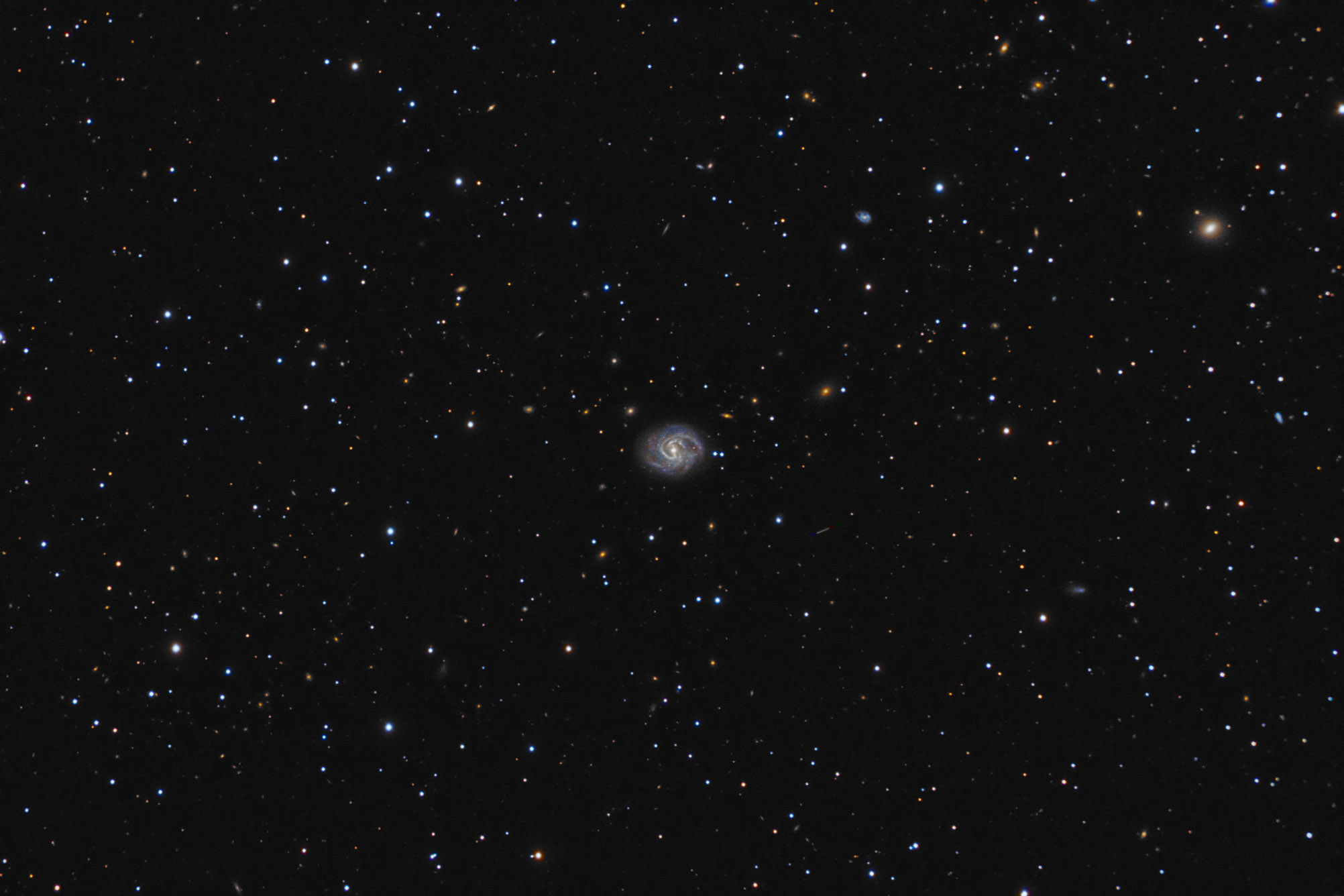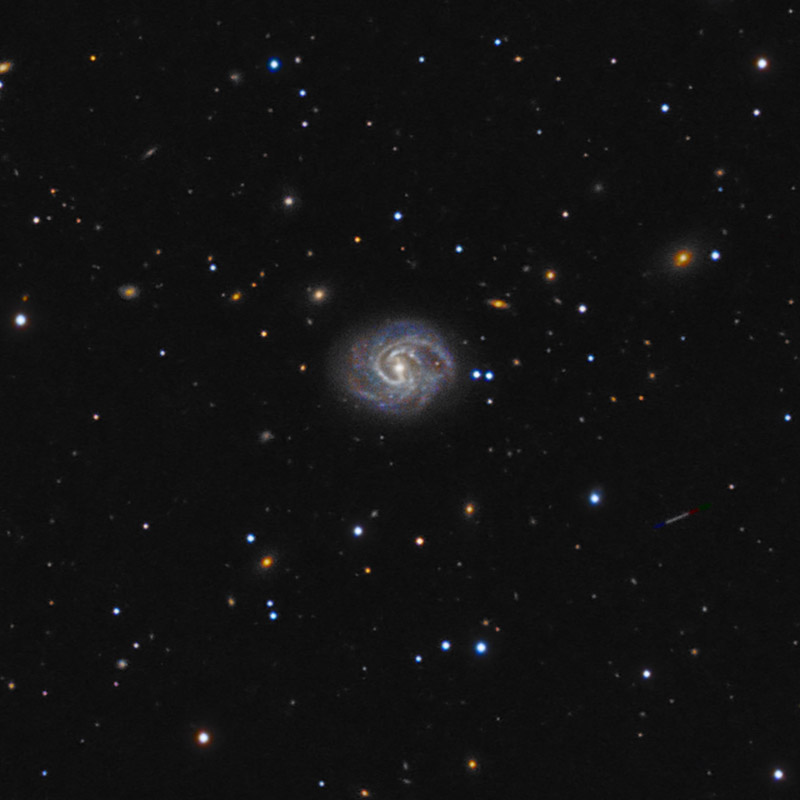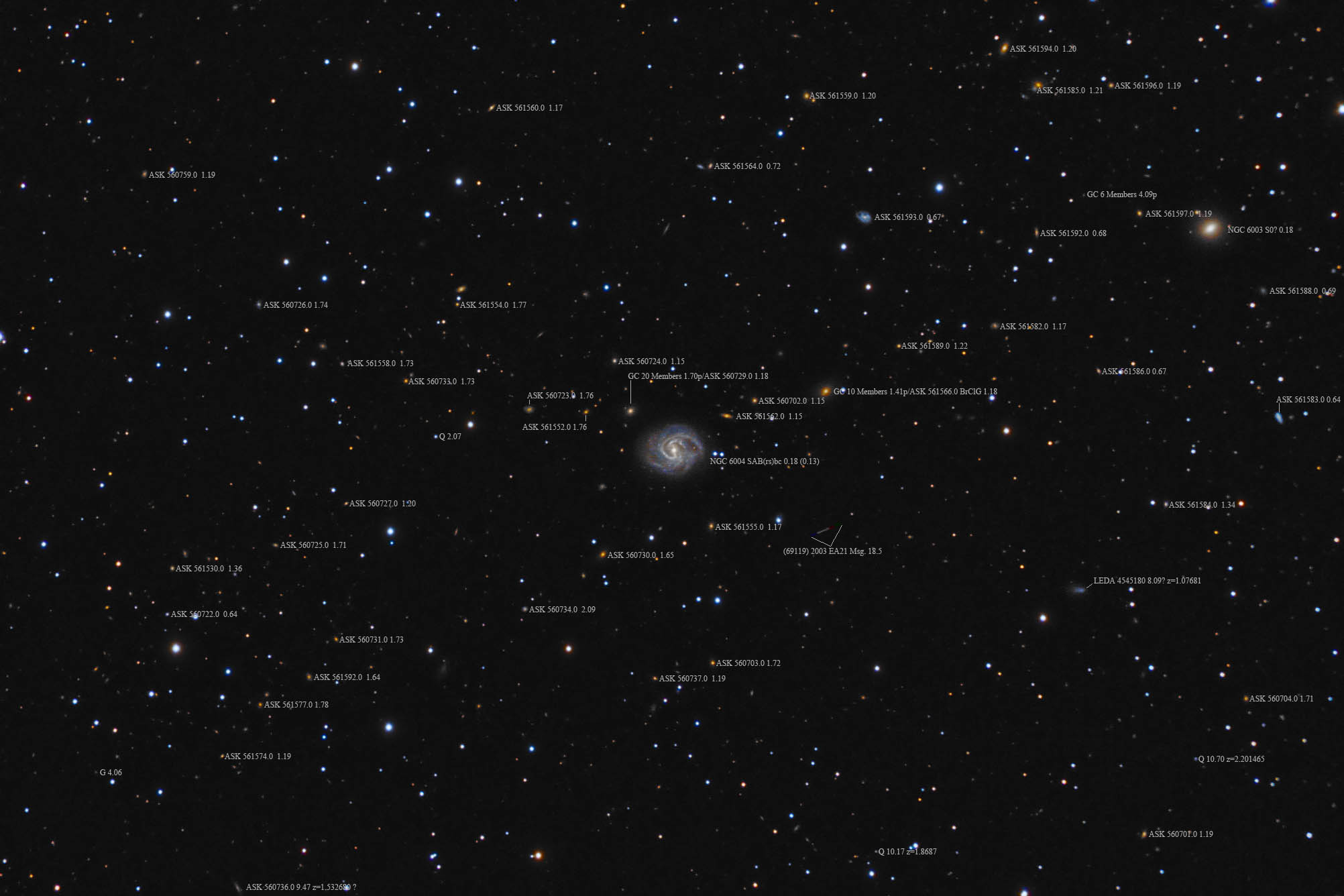Object name: NGC6004Designation(s): NGC6004, NGC6003, NGC 6003 and 6004 are a pair of galaxies in Serpens Caput about 180 million light-years away by cosmological redshift. NGC 6003 is a rather dull, featureless compact S0-like galaxy. NGC 6004 is the interesting barred spiral galaxy. The two arms coming off the bar are very different. The one off the southern bar is quite normal looking starting right at the end of the bar and making a nice neat spiral out to the edge of the galaxy. The northern bar makes a sudden faint jog east to connect to the end of that spiral arm. The arm is more a collection of bright spots that quickly fades away into an amorphous blob part of which takes a jog west to almost connect to the far end of the southern arm. Arm segments are scattered about as well. Both galaxies were discovered by Édouard Stephan but on different nights. NGC 6003 was seen on June 19, 1879 while NGC 6004 was seen 5 days earlier on June 14, 1879. Being only about 15 minutes of arc apart his field of view must have been rather small.
Besides the normal assortment of background objects, galaxies, galaxy clusters and an asteroid there are two objects for which the data at NED seems to have been collected by that all too common astronomer Sum Ting Wong.
LEDA 4545108 is a rather amorphous looking galaxy to the west of NGC 6004. NED gives it a redshift of z=1.07681 which puts it some 8 billion light-years distant light travel time and some 824,000 light-years across using its apparent size distance of 5.54 billion light-years. No way this can be correct. NED also has an essential note on it saying one source puts the redshift at z=0.01299 which puts it only 177 million light-years distant and 26,000 light-years in size. Thus a dwarf companion of NGC 6003 and NGC 6004. Why NED gives the obviously wrong data the front and center position I don't know.
Then there's the similar case of ASK 560736.0 at the bottom left of my image. Again it has a redshift way out of line at z=1.532680. This puts its look back time at 9.5 billion years and a size using the angular size distance of 5.8 billion light-years of 842,000 light-years. Now that's one big edge on galaxy. Again an "essential note" gives a redshift of z=0.05267 for a distance of about 690,000 light-years and a size of 100,000 light-years. Again a far more reasonable result.
Between this last galaxy and NGC 6004 is another amorphous blob of a galaxy. NED lists it only as an ultraviolet source which it uses for some hot stars, quasars, and blue galaxies. Ned makes no determination of what the source is and provides little data. Blue objects like this often don't make it into NED from the Sloan data. Why this is I've not been able to find out. I've asked both NED and Sloan but never gotten a reply. I have several pro astronomers I've asked that study galaxies who have not a clue either.
May was a poor month for imaging with a lot of data lost to clouds. This is my last May object. June is difficult since it isn't dark very long. I usually need more than one night to catch an object. Still, it appears to have been a better month than May. Though I may find a lot of the data isn't usable when I go to process it. Guess we'll find out together how much is usable.
14" LX200R @ f/10, L=4x10' RGB=2x10', STL-11000XM, Paramount ME Related Designation(s):2MASS J15492563+1901555, 2MASS J15502272+1856213, 2MASX J15492562+1901551, 2MASX J15502269+1856207, ARK 487, ASK 561567.0, ASK 561595.0, CALIFA 813, CGCG 107-043, CGCG 107-046, CGCG 1547.1+1911, CGCG 1548.1+1905, ECO 05052, GALEXASC J154925.64+190157.5 , HDCE 0921 NED001, HDCE 0921 NED003, IRAS 15481+1905, IRAS F15481+1905, LDCE 1152 NED001, LDCE 1152 NED003, MCG +03-40-048, MCG +03-40-051, NGC 6003, NGC 6004, NGC6003, NGC6004, NPM1G +19.0442, NSA 098523, NSA 098532, PGC 056130, PGC 056166, SDSS J154925.64+190155.4, SDSS J155022.71+185621.3, SDSS J155022.72+185621.3, SDSS J155022.72+185621.4, UGC 10048, UGC 10056, USGC U728 NED01, USGC U728 NED03, UZC J154925.6+190155, UZC J155022.7+185621, [M98j] 249 NED01, [M98j] 249 NED02, [PJY2015] 587739720308424791 , [TTL2012] 011783, [TTL2012] 253490, | | 

